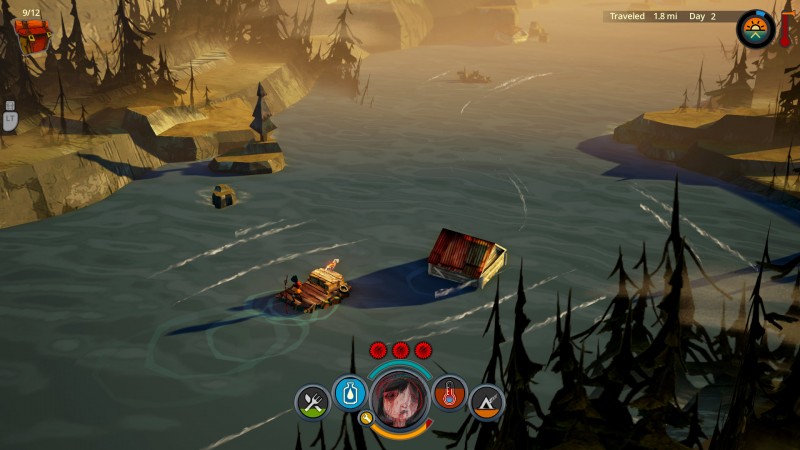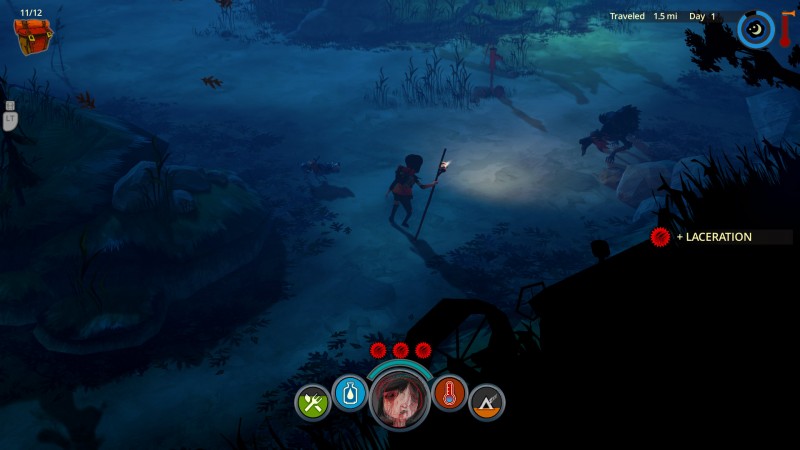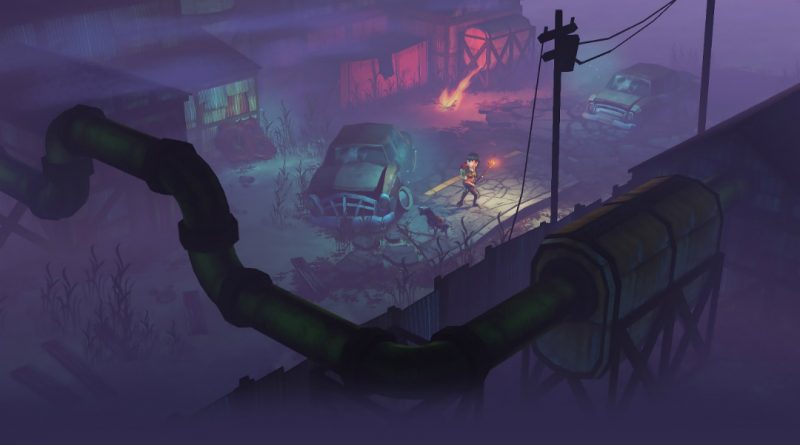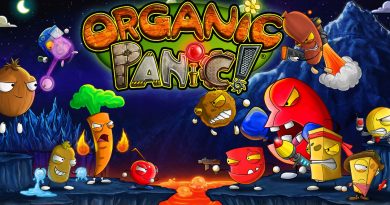The Flame in the Flood | Review
There comes a moment in The Flame in the Flood when you recognise the game-within-a-game. Suddenly the decisions required to help protagonist Scout survive take on new levels of importance. This tale of adventure and survival from new outfit The Molasses Flood hides the harshness of the wild and knife-edge decision making behind a veneer of beautiful visuals and a soundtrack of rare quality.
Set in the “backwaters of a forgotten post-societal America,” The Flame in the Flood is a story where every tiny decision has an impact on the likelihood that Scout, a young girl alone in the wilderness, will survive just that little bit longer. Scout, together with new canine companion Aesop, must trust in a rickety raft as together they travel downstream through a flooded landscape, stopping off to forage for supplies. This is no Sunday boat trip.

It’s the magnificent river that ties the adventure together, offering hope and danger in equal measure. At the mercy of the current, Scout can do little more than steer her vessel with the occasional lateral prod to avoid raft-damaging flotsam. Reading the current is key, though it’s not long before relatively benign waters and gentle currents give way to lengths of cascading white water. Here the currents are invisible, the raft gains speed and the camera moves in to restrict the view. Grippng stuff.
The river is the gateway to Scout’s salvation. It provides access to campsites, forest clearings, abandoned churches and other remnants of civilisation throughout her journey. Here, Scout can forage for the resources she needs to survive, build a fire, or take shelter from the elements. The wilderness of The Flame in the Flood is a dangerous place. To survive, Scout will need food, water, protection from the elements and enough rest to stave off exhaustion.
To stay alive, Scout needs sustenance; a meal as simple as a handful of grubs and a jar of clean water sounds like a last resort, especially when there’s the prospect of cooked meat and dandelion tea (with its healing properties). Such a repast requires both resources and tools, though. More often than not you’ll be longing for a handful of grubs when poor Scout is on the edge of starvation with nothing more than raw meat or a mouldy something to eat. Both will help fill Scout’s belly, but offer debilitating side effects.
Survival depends on finding the right resources in sufficient quantities. Scout must craft the items she needs from meagre pickings. From simple stone tools to traps for catching game, water purifiers, warm clothing, more nutritious food, medicine and medical supplies like bandages and splints, Scout’s use of resources must be carefully judged. With an inventory limited in space and no way of revisiting a place once Scout’s departed – the river’s currents are too strong – decisions about what to take and what must be left behind quickly become agonising.
Decisions must be made about where to land, too. For every jetty Scout berths at, there will be several more she’s forced to bypass, the strong current sweeping her helplessly past before she can manoeuvre her craft across the river.

As dangerous as the river is with its unpredictable white water and raft-damaging floating debris, making landfall offers even greater risk. Alongside the dangers of eating tainted food – which left untreated will lead to Scout’s inevitable demise – death can come in any number of ways. Starvation, dehydration, dysentery, attacked by wolves, gored by wild boars, bitten by snakes, exposure, broken bones, infection, countless more. Drowning seems almost the gentlest option.
As dangerous as the environment is for Scout, her canine companion Aesop seems mercifully robust. You can concentrate on Scout’s survival without worrying about Aesop – in fact he’s of tremendous help, barking at resources overlooked, or warning of approaching danger from wolves or wild boars. He has his own inventory too – six slots Scout can use to bolster her own meagre supplies. And here’s the delicious meta-game. After each death, Scout loses all her inventory, while Aesop retains his for the next play through.
This simple – and brilliant – mechanic changes the way you think about Scout’s survival. After a run of bad luck, Scout may find herself shivering, starving and bleeding. In Aesop’s pack she stashed some nutritious Ash Cakes from happier times. Eating them now will hold off starvation a little longer, perhaps giving you time to guide Scout to the next safe landing. Surely there she’ll find shelter and bandages to stem the bleeding?
Or, maybe there’s another way. If you have the stomach for it – and if you recognise the finality of Scout’s predicament – you leave the food where it is, and start the next play through with a valuable commodity from the off. There’s a cost though. This young girl’s survival is your responsibility, and yours alone. Choosing not to eat those nutritious cakes means watching the screen fade to black as Scout slowly, agonisingly starves to death. And you must do so in the knowledge you could have helped her.
The decisions you make each play through affect not just this Scout’s chances, but those of future Scouts, too. In time, you may choose to forgo an attempt at salvation and instead forfeit Scout’s life from the off to bolster the resources available to a future Scout. You make such a decision in the full knowledge that doing so condemns a young girl to a death to which you are the only witness.

Upon each death you will see an overview of Scout’s journey overlaid on a map of the river – success measured in days survived and miles travelled. It’s sobering when your best is five days and seven miles, having reached only the second of the story’s ten regions. The game’s Endless mode – a true test of survival with no salvation in sight – offers Achievements for 200 miles of travel and 40 days survival without ever sleeping in a shelter. Those successes feel some way off right now.
With a river that forces one-way travel – even with a fully upgraded motorised raft, the currents are too strong to allow for backtracking – you would be forgiven for thinking The Flame in the Flood would be a linear experience. That is far from the case. There’s an almost Rogue-like mechanic at play; the procedurally generated river and settlements make it impossible to memorise the best currents to follow or the best landings to loot.
Visually the game has a painted aesthetic that’s quite unlike anything else; it beautifully hides the harshness of the wilderness and the challenge of survival. The soundtrack – whilst perhaps not to everyone’s taste – suits the atmosphere perfectly; alt-country strings and lyrics imbuing feelings of both sadness and hope as you guide Scout on her journey. This is a work of beauty and imagination.

There’s very little here to prevent us from recommending The Flame in the Flood. The Molasses Flood have created an experience that stands alongside other survival adventure classics including Don’t Starve and I Am Alive. From the magnificent river to the dark, twisted forests and abandoned settlements, this game is heavy on beauty, atmosphere and – most of all – challenge. Scout’s survival rests solely in your hands and in your ability to plan, adapt and make tough – sometimes heart-wrenching – decisions. Be warned: The Flame in the Flood is not a game for the faint of heart. There’s no hand-holding here and whilst the crafting mechanic is explicitly helpful the rest of the game presents a severe and lengthy challenge.
The Flame in the Flood stands head and shoulders above any other game of its type, and is simply one of the very best ID@Xbox games we have ever played. Outstanding.
The Flame in the Flood is available from the Xbox Store for £15.99, the PlayStation Store for £11.99, the Nintendo eStore for £14.99 (though discounted to £3.74 until 13 April) and on Steam for £14.99.




